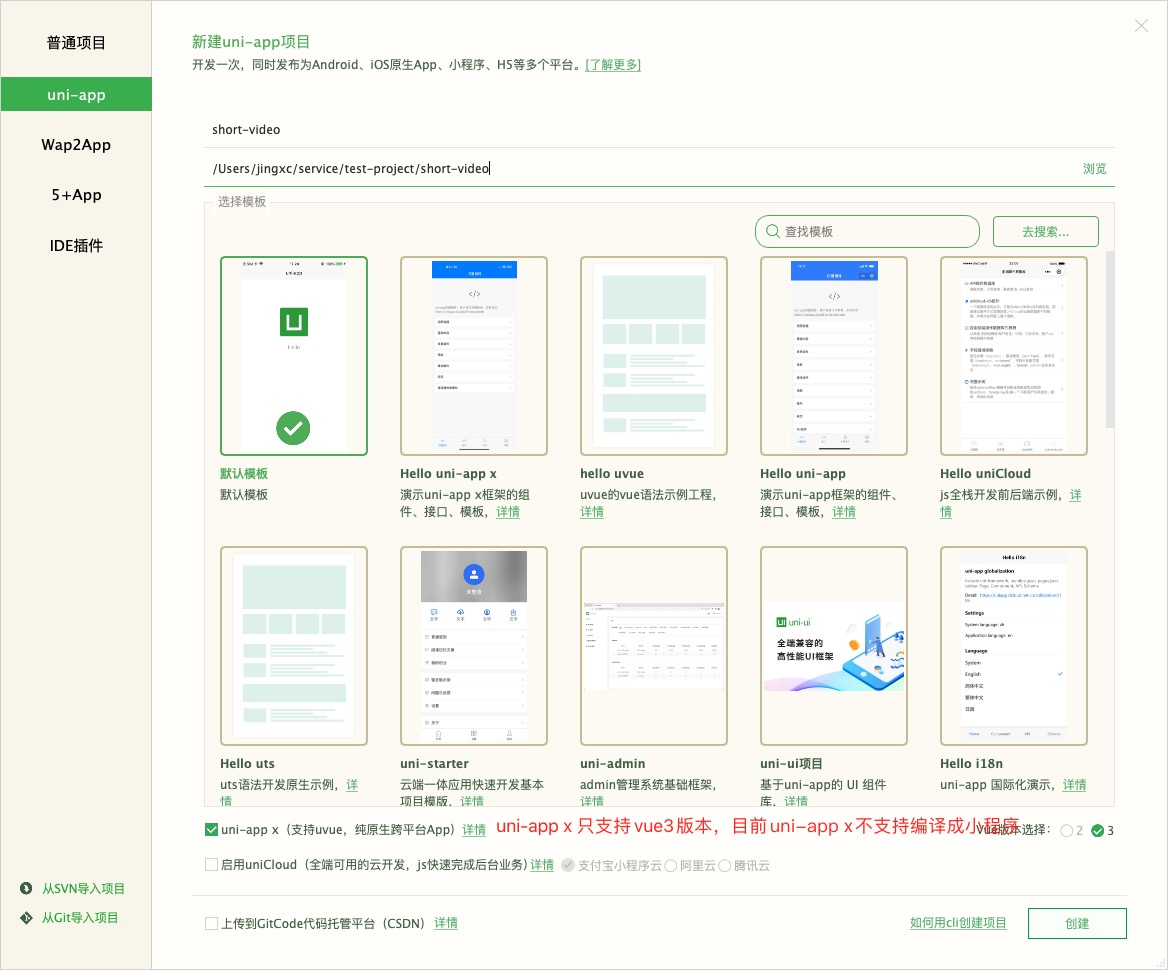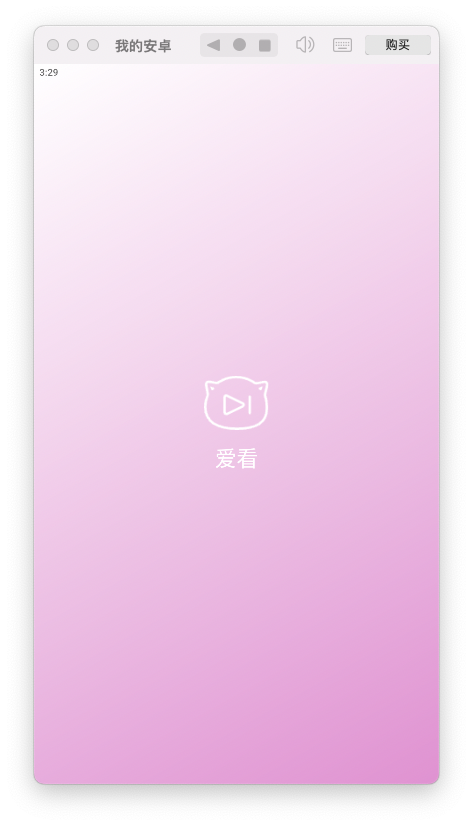短视频app
短视频app
一. 创建项目
1.1 前言
项目使用的工具:
- MAC M1:苹果M1芯片笔记本
- HBuilderX:用于app开发
- IDEA:用于后端开发
- PhpWebStudy:用于数据库,Redis,静态资源文件等控制
项目使用语言极其版本:
- 后端:jdk1.8,mysql8,redis7.2.4
- 前端:vue3,uts,uni-app x
特别说明
uni-app x,是下一代 uni-app,是一个跨平台应用开发引擎。
uni-app x 是一个庞大的工程,它包括uts语言、uvue渲染引擎、uni的组件和API、以及扩展机制。
uts是一门类ts的、跨平台的、新语言。uts在iOS端编译为swift、在Android端编译为kotlin、在Web端编译为js。
在Android平台,uni-app x 的工程被编译为kotlin代码,本质上是换了vue写法的原生kotlin应用,在性能上与原生kotlin一致。

1.2 vue2与vue3区别
属性变量定义
vue2:属性变量定义
<template>
<div class="hello">
<div style="display: flex;justify-content: center;">
<div class="base-css">
简单属性
<div>name:{{name}}</div>
<div style="margin: 30px;"><button @click="updateName">更新</button></div>
</div>
<div class="object-css">
对象属性
<div>age:{{user.age}}</div>
<div style="margin: 30px;"><button @click="updateAge">更新</button></div>
</div>
</div>
</div>
</template>
<script>
export default {
data() {
return {
name: '我是vue2',
user: {
age: 12
}
}
},
methods: {
updateName() {
this.name = "更新后vue2";
},
updateAge() {
this.user.age = 18;
}
}
}
</script>
<style scoped>
.object-css {
margin-left: 30px;
width: 300px;
height: 200px;
border: 1px solid red;
border-radius: 20px;
}
.base-css{
width: 300px;
height: 200px;
border: 1px solid blue;
border-radius: 20px;
}
</style>
vue3属性变量定义
<template>
<div class="hello">
<div style="display: flex;justify-content: center;">
<div class="base-css">
简单属性
<div>name:{{name}}</div>
<div style="margin: 30px;"><button @click="updateName">更新</button></div>
</div>
<div class="object-css">
对象属性
<div>age:{{user.age}}</div>
<div style="margin: 30px;"><button @click="updateAge">更新</button></div>
</div>
<div class="object-css">
<div v-for="item in list">{{item}}</div>
<div style="margin: 30px;"><button @click="updateList">更新</button></div>
</div>
</div>
</div>
</template>
<script setup>
import {ref,reactive} from 'vue';
const name = ref('我是vue3');
const user = reactive({
age:12
});
const list = reactive([1,2,3])
const updateName = ()=>{
name.value = "更新后vue3";
};
const updateAge = ()=>{
user.age = 18
};
const updateList=()=>{
//list = reactive([3,4,5]);
list.splice(0,list.length ,...[3,4,5])
}
</script>
<style scoped>
.object-css {
margin-left: 30px;
width: 300px;
height: 200px;
border: 1px solid red;
border-radius: 20px;
}
.base-css{
width: 300px;
height: 200px;
border: 1px solid blue;
border-radius: 20px;
}
</style>
路由的创建以及使用
首先是引入依赖,VUE2和VUE3引入方式一致,只不过引用的版本不一致
- vue2中使用
npm install vue-router@3 - vue3中使用
npm install vue-router@4
然后是定义路由:定义路由可以直接定义在main.js中,也可以提出来公共的路由文件router.js(名字随意)
// vue2中的路由文件配置
import Vue from 'vue'//vue依赖
import VueRouter from 'vue-router'//路由依赖
import Login from '@/views/Login/Login.vue'//页面文件
import Home from '@/views/Home/Home.vue'//页面文件
Vue.use(VueRouter)//使用路由
const routes = [{
path: "/",
redirect: "/login"
},
{
path: "/login",
component: Login
},
{
path: "/home",
component: Home
},
]
const router = new VueRouter({
mode: 'history',//确定地址访问形式
routes
})
export default router
// vue3中的路由文件配置
import { createRouter, createWebHistory } from 'vue-router';//路由依赖
import Login from '../views/Login/Login.vue'//页面文件,不能使用@引用
import Home from '../views/Home/Home.vue'
const routes = [{
path: "/",
redirect: "/login"
},
{
path: "/login",
component: Login
},
{
path: "/home",
component: Home
},
]
// 创建router实例
const router = createRouter({
history: createWebHistory(),
routes,
});
export default router
接下来是在main.js中管理配置路由文件
- 在vue2中,将
router文件引入到new Vue({})中即可 - 在vue3中,
createApp(App).use(router)即可
最后是如何使用
- 在vue2中直接使用vue实例this来使用
this.$router.push('/home')即可 - 在vue3中首先得引入依赖
import { useRoute,useRouter } from 'vue-router';然后使用router.push('/home')即可
全局属性变量
在vue2中,定义全局属性变量是通过函数的原型对象prototype来实现的 使用
Vue.prototype即可定义全局属性变量,通过实例对象this来获取在vue3中是是通过全局配置选项
globalProperties来实现全局变量的定义的 使用的时候先获取当前运行的实例对象getCurrentInstance(),在通过代理对象获取全局属性
1.3 启动页面
这里我选取了一个温馨的颜色#E091D3,在h5或者是小程序创建时,可以直接使用css的 background-image来进行背景图片的控制的,但是uvue不支持这种方式
App平台
App平台暂不支持背景图,仅支持linear-gradient设置背景渐变色。 linear-gradient仅支持三个参数,格式如下:
linear-gradient(<direction>, <color-start>, <color-stop>)
所以启动页面背景最后控制css就是这样子了
.content {
display: flex;
align-items: center;
justify-content: center;
background-image: linear-gradient(to bottom right,#fff,#E091D3);
height: 100%;
}
特别说明
之前在h5中view内部的文字样式可以直接通过css来控制,现在css控制不了view内部样式,
例:font-size只能适用组件
- text
- button
- input
- textarea
所以我们最后的初始页面就长成这样了:

使用uni-app x的时候还有许多需要注意的地方,有一些特定的css样式只能用在特定的标签上,不能混着用,目前我就遇到
- width:100vw 是错误的
- text-align: center; 添加在view标签上是错误的
- image标签暂时不支持svg的图片格式
- uni.request不能转成同步的
- progress组件添加percent属性如果是常量后会闪退,必须设置成变量才可以
